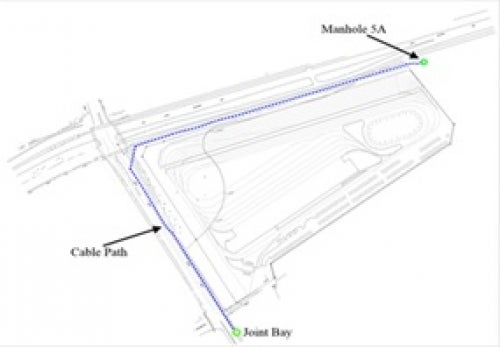If you would like to see more information on this case study, click here!
You can request this case study and a WCDE staff member will get back to you.
Installation of underground high voltage transmission lines mainly occurs in urban and suburban areas; the limited space in these high-density areas makes overhead transmission lines a suboptimal solution. As installation of underground cables present issues separate from overhead transmission lines, analyses of underground cable pulling tensions and sidewall pressures on all installations are normally conducted in order to avoid hazards and ensure cable integrity is maintained. A contracting company that specializes in high voltage transmission services is currently in the process of evaluating a recently proposed underground cable installation at a Toronto, Ontario job site. Figure 1 illustrates the proposed underground cable path for this application, from Joint Bay to Manhole 5A.
Michael Hui, a second year electrical engineering co-op from the University of Waterloo, was asked to conduct evaluations to ensure that the proposed cable installation methods at the Toronto job site were safe for use.

Figure 1 - Plan for cable pulling path
This case study is intended to teach students application of engineering design concepts in real-life engineering problems. Students will analyze installed underground high voltage cables that serve in transmission of power through high-density areas. Students will be required to apply course concepts to develop solutions for problems encountered by underground high voltage transmission systems. The learning objective of this case study is to apply the knowledge of material properties and practice identifying design criteria in a real world problem. Students will be asked to evaluate the case based on the given information, develop a conceptual solution and then prove the solution using calculations.
If you would like to see more information on this case study, click here!
You can request this case study and a WCDE staff member will get back to you.
Contact Waterloo Cases in Design Engineering
Steve Lambert
Tel: (519) 888-4728
Email: steve@uwaterloo.ca
The University of Waterloo acknowledges that much of our work takes place on the traditional territory of the Neutral, Anishinaabeg and Haudenosaunee peoples. Our main campus is situated on the Haldimand Tract, the land granted to the Six Nations that includes six miles on each side of the Grand River. Our active work toward reconciliation takes place across our campuses through research, learning, teaching, and community building, and is co-ordinated within the Office of Indigenous Relations.